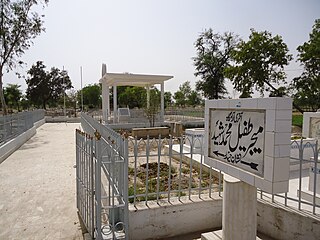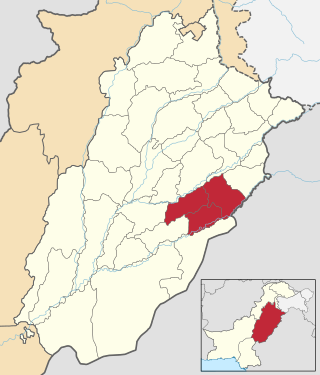
Sahiwal, formerly known as Montgomery, is a city in Punjab, Pakistan. It is the 21st largest city of Pakistan by population and the administrative capital of both Sahiwal District and Sahiwal Division. Sahiwal is approximately 180 km from the major city Lahore and 100 km from Faisalabad and lies between Lahore and Multan. Sahiwal is approximately 152 meters above the sea level.

Okara District, is a district of Punjab, Pakistan. It became a separate district in 1982, prior to that it was part of Sahiwal District.

Sahiwal District, formerly known as Montgomery district, is a district in the Punjab province of Pakistan. In 1998, it had a population of 1,843,194 people, 16.27% of which were in urban areas. Since 2008, Sahiwal District, Okara District, and Pakpattan District have comprised the Sahiwal Division. The city of Sahiwal is the capital of the district and the division.

Vehari District is a district in the Punjab province of Pakistan. The city of Vehari is the capital of district while Burewala is the largest city of the district.
Kharal is a Punjabi tribe predominantly found in the Sandal Bar of the Punjab Region of Pakistan, with significant numbers also present in Pind Dadan Khan, Muzaffargarh, Multan, Bahawalpur and further south to Sindh.
The Sial or Siyal is a Punjabi Rajput & Jat tribe in the Punjab region of the Indian subcontinent, split between India and Pakistan.

Majha is a region located in the central parts of the historical Punjab region split between India and Pakistan. It extends north from the right banks of the river Beas, and reaches as far north as the river Jhelum. People of the Majha region are given the demonym "Mājhī" or "Majhail". Most inhabitants of the region speak the Majhi dialect, which is the basis of the standard register of the Punjabi language. The most populous city in the area is Lahore on the Pakistani side, and Amritsar on the Indian side of the border.

Pakpattan District, is a district of Punjab province in Pakistan, Pakpattan is the district capital. According to the 1998 census of Pakistan, it had a population of 1,286,680 of which 14% were urban. It has since risen to 1,563,000.

Pakpattan, often referred to as Pākpattan Sharīf, is the capital city of the Pakpattan District, located in Punjab province of Pakistan. It is the 48th largest city of Pakistan by population according to the 2017 census. . Pakpattan is the seat of Pakistan's Chisti order of Sufism, and is a major pilgrimage destination on account of the shrine of Fariduddin Ganjshakar, the renowned Punjabi poet and Sufi saint commonly referred to as Baba Farid. The annual urs fair in his honour draws an estimated 2 million visitors to the town.
Montgomery District was an administrative district of the former Punjab Province of British India, in what is now Pakistan. Named after Sir Robert Montgomery, it lay in the Bari Doab, or the tract between the Sutlej and the Ravi rivers, extending also across the Ravi into the Rechna Doab, which lies between the Ravi and the Chenab. The administrative headquarters was the town of Montgomery, present-day Sahiwal. In 1967, the name of Montgomery District was changed to Sahiwal District.
Neeli Bar is a geographical region in Punjab, Pakistan. It is between the rivers Ravi and Satluj.
The Bar Region, or the Bars, is an area in central Punjab, now part of the Punjab Province of Pakistan. The area consists of agricultural land that was cleared in the nineteenth century for the then 'new' canal irrigation system that the British were developing at the time. The soil of the Bar Region is fertile. The plains of fertile land have been created by the stream deposits driven by the many rivers flowing from the Himalayas.

Kamalia is a city in the Toba Tek Singh District of Punjab, Pakistan. It is the administrative center of Kamalia Tehsil. It is the 42nd largest city of Pakistan by population and has a lot more population compared to nearby cities like Rajana, Chichawatni and Pir Mahal.
Baar di boli is a dialect of Punjabi language spoken in Hafizabad, mandi bahhudin,shaikupura ,chiniot ,sargodha ,khushab,chakwal ,jhang,faislabad,toba tek Singh, sahiwal, khanewal, okara, pakkpatan, bahawalngar,vehari,hasilpur,pind dad khan and Nankana Sahib districts. Open main menu Wikimedia Incubator Search Wp/jat/باروی زبان Language Watch Edit < Wp | jat Wp > jat > باروی زبان باروی زبان جٹکی نوں اہدے ہن. ایہ بار دے علاقیاں دی زبان ہے.

Renala Khurd is an administrative subdivision (tehsil) of Okara District in the Punjab province of Pakistan. It is administratively subdivided into 18 Union Councils, two of which form the tehsil capital Renala Khurd.
Khaira is a Punjabi surname and Jat clan that is not to be confused with Kheirra, also a Jat clan, in Punjab, India & Punjab, Pakistan. The surname is particularly common in the city of Amritsar where majority of the Khairas (Khehras)were settled before the 1947 Partition of India. The majority of Khehras live in Khadur Sahib tehsil of district Tarn Taran in Punjab, India, in villages Odhar, Nagoke, Kotli Saru Khan etc. There are many variations of this surname such as Khara and Khehra. In India, Khehras live in Faridkot, Batala, Kapurthala, Gurdaspur, Jalandhar and Moga etc. in addition to Amritsar. In Punjab, Pakistan Khairas or Khehras live in Harappa (Sahiwal), (Girote) Khushab, Gojra, Kharrian (Gujrat), Dajkot (Faisalabad), Rahim Yar Khan and Lahore etc. Khehras of Pakistani Punjab are mostly migrated in 1947 from Indian Punjab e.g. Khehras of Harappa migrated from Hassan Bhatti near Ferozepur. Kheirras (کھیڑا) live in Multan, Muzaffargarh, Girote and other parts of southern Punjab & in some areas of Sindh, Pakistan.

Sahiwal Division is one of the nine Divisions of Punjab province, Pakistan.

The Lower Bari Doab Canal is a canal in Punjab, Pakistan. Part of the part of the second-largest irrigation system of the province, it serves approximately 275,000 farmsteads. It is located south-west of Lahore and runs alongside the River Ravi.
Sardar Ran Singh Nakai was the third chief of the Nakai Misl. He was born to the aristocratic Sandhu family of Jat Sikhs. He distinguished himself at an early age in campaigns with his father, Natha Singh Sandhu and uncle, the legendary Heera Singh Sandhu who was the founder of the Misl. Ran Singh was a fierce warrior and a powerful misldar under his leadership the misl was at its highest. He was the father of Maharani Datar Kaur and the father-in-law of Maharaja Ranjit Singh, the founder of the Sikh Empire. He was the grandfather of Maharaja Kharak Singh, the second king of the Sikh Empire and Sardar Kahan Singh Nakai, the last chief of the Nakai Misl.













